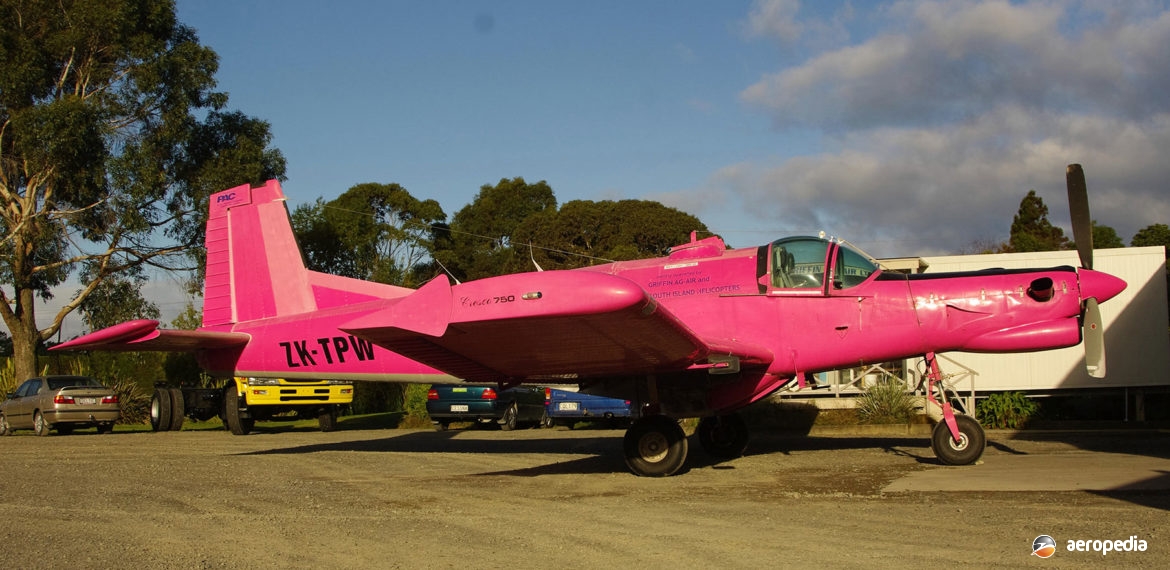Photograph:
PAC Cresco 08-600 ZK-TPW (c/n 034) near Palmerston North, New Zealand in May 2012 (David C Eyre)
Country of origin:
New Zealand
Description:
Single or two seat dual control utility aircraft
Power Plant:
One 448 kw (600 shp) Pratt & Whitney PT6A-34AG turboprop
Specifications:
- Wingspan: 12.81 m (42 ft)
- Length: 11.06 m (36 ft 3¼ in)
- Height: 3.42 m (11 ft 2½ in)
- Wing area: 27.31 m² (294 sq ft)
- Max speed at sea level: 328 km/h (204 mph)
- Max cruising speed at 75% power: 250 km/h (155 mph)
- Stalling speed flaps down: 97 km/h (60 mph)
- Max rate of climb at sea level: 321 m/min (1,054 ft/min)
- Service ceiling: 6,400 m (21,000 ft)
- Range with max fuel, no reserves: 876 km (537 miles)
- Empty weight: 1,247 kg (2,750 lb)
- Loaded weight: 2,925 kg (6,450 lb)
- Max disposable load in agricultural configuration, including fuel: 1,851 kg (4,080 lb)
History:
The Cresco was a logical development of the Fletcher FU-24 agricultural aircraft, which was produced in large numbers for many years, firstly in the USA, and later in New Zealand from 1955. The Cresco, although using many parts of the FU-24-954, was completely re-designed from the ground up for turbine power and was not a stretched aircraft like the FU-1060/1160. The installing of the turboprop engine permitted an increase in maximum take-off weight, and thus an increase in the maximum disposable load from 1,052 kg (2,320 lb) in the FU-24-954 to 1,851 kg (4,080 lb).
The FU-1060 was essentially a stretched development of the FU-24 by Air Parts (NZ) Ltd at Hamilton with a Pratt & Whitney 373 kw (500 shp) PT6A-20 turboprop, design work commencing in June 1966, the prototype flying for the first time in July 1967. By mid-1968 it was undergoing certification trials. It was intended not to replace but to supplement the FU-24 series. The FU-1160 was essentially similar to the FU-1060 except for weight and performance variations brought about by the installation of the 395 kw (530 shp) AiResearch TPE 331 engine. The FU-1160 resulted from the installation of a FU-24 airframe with the turbine powerplant, whereas the FU-1060 was an entirely new airframe and first flew in December 1967. The plan was to modify existing airframes, a third turbine powered aircraft being built, also with a TPE331 engine, becoming the Fletcher FU-1284 and registered ZK-CYY.
The prototype of the Cresco, the 08-600 (ZK-LTP), was flown for the first time on 28 February 1979. The first production aircraft made its initial flight in 1980, and the type entered service in 1982. Nine aircraft were built and fitted with the de-rated 448 kw (600 shp) Avco Lycoming LTP-101 engine. After 1992 all production aircraft were fitted with the Pratt & Whitney PT6A-34AG turboprop, the first being ZK-TMN (c/n 10) which later became ZK-PWT. For the installation of the Pratt & Whitney engine, the front fuselage was modified. These aircraft are still known as the PAC 08-600 but use the commercial name Cresco 750. The first flight of this model was made on 18 November 1992.
All the Crescos are 08-600s, no matter what engine is installed, and they have dual controls. Later models from c/n 19 on have machined spar caps, a 2,273 litre (500 Imp gal) hopper and a wide hopper box. A number of Crescos have been fitted with more powerful PT6 engines, including a few which previously had piston engines fitted. Some 30 examples of the type have been completed. Sixteen examples appear on the New Zealand register and three on the Australian register.
The Cresco was designed mainly for use as a two-tonne aerial topdressing aircraft in New Zealand. As it was also aimed at the utility aircraft market, examples have been adapted for aerial survey and high altitude skydiving.
One Cresco 600 (ZK-JAD) of Jet Spread was fitted in mock-up form with 6.98-cm (2.75-in) rocket pods, had armour plating for the engine and crew, and 7.62 mm (0.30 in) machine guns. It was configured to carry 113 kg (250 lb) or 227 kg (500 lb) bombs, and 80 mm Sura FL air-to-ground rockets following representations to PAC for a COIN configured variant but this model did not go into production. New-build Crescos have been supplied around the world for a variety of roles, and have been seen in Malaysia, Bangladesh, Australia etc.
In 1992 the Cresco O8-750 was launched with the 559 kw (750 shp) Pratt & Whitney PT6A-34G engine, the first of this model being delivered in December 1992. This variant had a larger hopper with a capacity of 2,000 litres (440 Imp gals) and had four integral fuel tanks in the wing centre section with a total capacity of 545.5 litres (120 Imp gals). Nine were sold during 1996 and 1997. Production concluded after 38 had been completed (c/ns 1 to 39 – c/n 13 was not allocated) in order for the Company to devote more energy towards the PAC 750 series.
Operators have included Super Air Ltd at Hamilton, Superair Australia, Farmers Air Ltd at Gisborne, Ravensdown Aerowork Ltd of Wanganui, Kiwi Air Ltd of Gisborne, Griffin Ag-Air Ltd at Palmerston North, Aerospread Ltd at Napier, Otago Airspread Ltd at Mosgiel, Skydive Cairns Pty Ltd, Skydive Queenstown Ltd and the Department of Agricultural Extension – Plant Protection Wing, Dhaka, Bangladesh, which operated three as S2-AAB, S2-AAC and S2-AAE.
In late 2019 the Pacific Aerospace CEO announced a New Zealand customer had placed an order for new Cresco II aircraft and that the type, with some modifications relating mainly to pilot safety and comfort, would be placed back into production after some 20 years.

